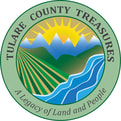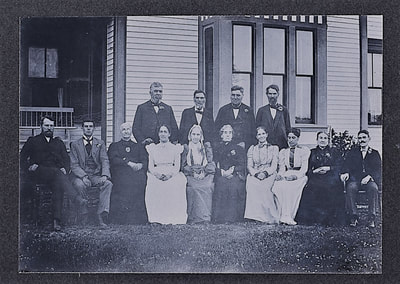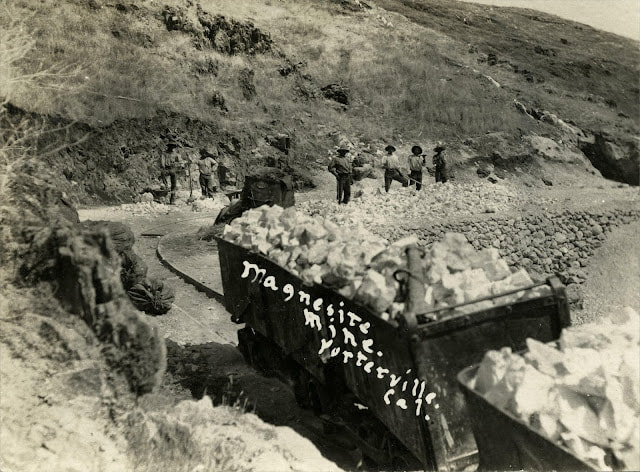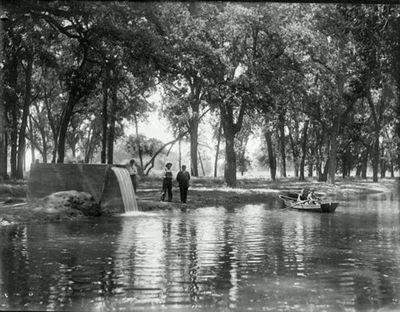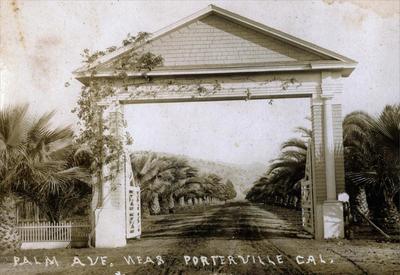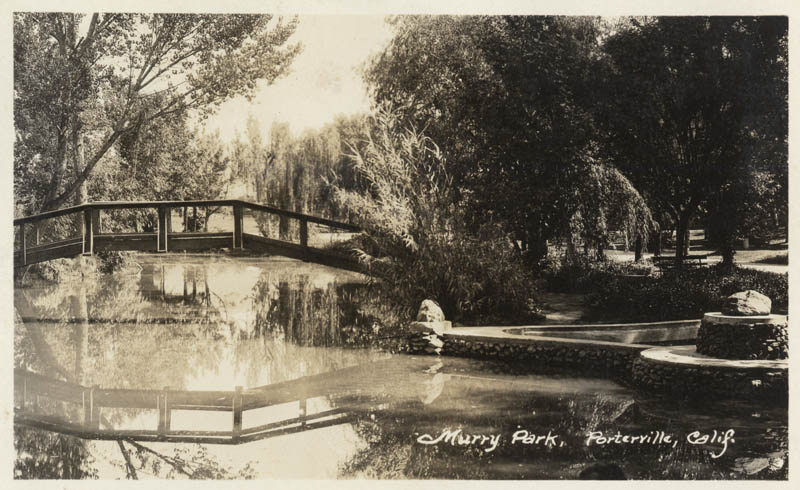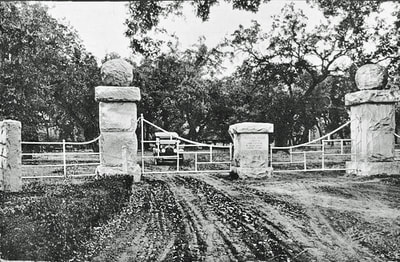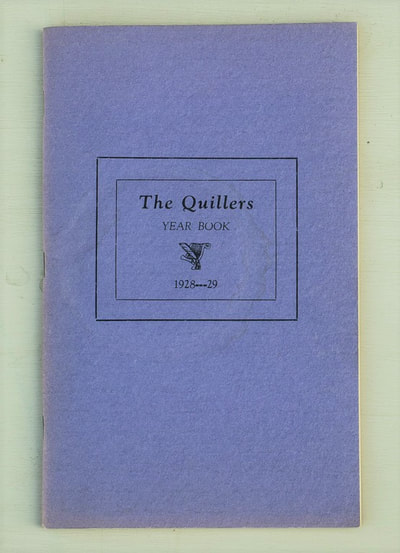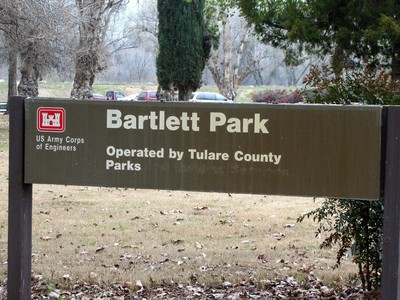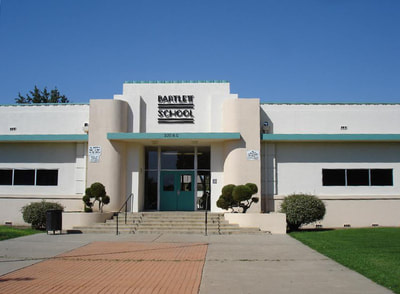|
"Your town, your schools, your community spirit and your newspaper will be just what you make them." -- W.P. Bartlett 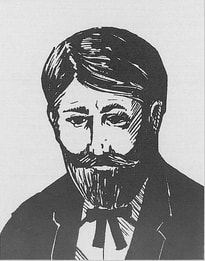
"[Bartlett] became interested in the manufacture of newsprint. One of the filler ingredients was calcined magnesite. Bartlett invested in magnesite mines in Northern California, and in 1892 came to Porterville where he and George Stanley bought magnesite mines northeast of Porterville. . . . In 1900 the Willamette Pulp and Paper Company bought the mines in Porterville and hired Bartlett as resident manager." -- Tulare County Library, Annie R. Mitchell History Room
 El Granito High School El Granito High School
"Although the Bartletts had no children, they were very much interested in their community's schools. . . . A few years after Bartlett moved to Porterville bonds were voted to build a new High School. Mr. Bartlett suggested that the best building for the money available could be built of native granite and he offered to oversee the job and guarantee the costs." -- Los Tulares #44, June, 1960
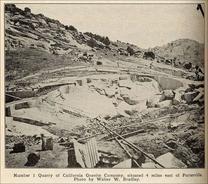
The granite was quarried on the west side of Porterville Rocky Hill just south of Bartlett's magnesite mine. . . . Magnesite workers were used in the quarry . . . . Bartlett was unable to complete the building for the stipulated amount and paid some two thousand dollars of the cost himself. . . . The Porterville High School publication El Granito memorializes this old granite structure." -- Los Tulares #44, June, 1960

"It was interest in the people and especially for families of children, that, in response to his vision of what could be accomplished in providing recreation grounds enabled him to use his genius and without any compensation whatsoever to give liberally of his time and energies to the establishment of our county parks and the Porterville city park." -- Rev. John A. Milligan
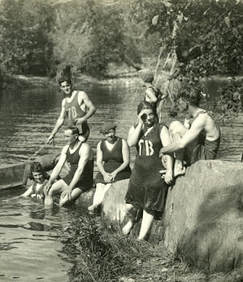
He watched with interest the improvement of these public playgrounds because he was a lover of the beautiful, and the more because the people, and especially the children, were to enjoy these privileges." -- Rev. John A. Milligan
 Wild Clematis Wild Clematis
"Beginning with two massive stone pyramids covered with lichen and flowers at the south entrance near Success bridge, wild shrubs and flower gardens line either side of the driveway for several hundred feet, with shaded table[s] and seats for visitors. The boundary fences are planted with wild clematis."-- W. P. Bartlett
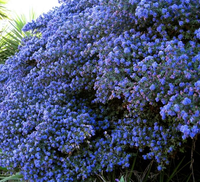 Ceanothus (California Lilac) Ceanothus (California Lilac)
"Within are six kinds of wild lilac ranging in color from white to deepest blue, the crimson-flowered sweet shrub, the sumac, the California coffee-berry, manzanita, mountain mahogany, bush monkey-flower, toyon, perennial aster, golden rod, wild fuchsia, wild rose, tree lupine, annual lupines, ash, elder, and more than 100 other kinds of shade trees, shrubs, and perennial flowers." -- W. P. Bartlett
"(Thus Mr. Bartlett planted not only for beauty but also for conservation.)" -- Ira H. Stiner 
"His formal education had ceased after grammar school, but he continued to educate himself through an encyclopedia." -- Bartlett Bio 4 from Tulare County Library, Annie R. Mitchell History Room
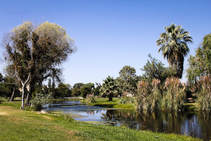
"A great nature lover, he possessed a decided fondness for mountain scenery. He made frequent trips through the Coast Range and Sierras, each of which added to a fund of information for use in subsequent literary work. A series of his articles on the scenery of the high Sierras was published in San Francisco newspapers and later copied by numerous journals on the east coast and in Europe." -- Bartlett Bio 4 from Annie Mitchell History Room
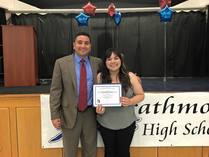
"I have for many years been greatly interested in young men and young women of special talent and industry, and I hope by means of the trust fund hereby created to serve the public interest and welfare by the development of talent and ability." -- from Bartlett's Will in Decree of Distribution
Photos for this article by: John Greening and Laurie Schwaller; and courtesy of California Press Foundation; California State Library, California History Room; California State Mineralogist's Report, 1919; Peter Neeley/My Old Tulare County Pics; The Living New Deal (photo by Marcia Crabtree Skinner); The Porterville Recorder; Theodore Payne foundation; Tulare County Library, Annie R. Mitchell History Room; U.S. Department of Energy; University of California Division of Agriculture and Natural Resources; the W.P. Bartlett Trust Scholarship; and the W.P. Bartlett Trustee Archives
|
The Lasting Legacy of William Pitt Bartlett, Benefactor of Tulare County
William Pitt Bartlett left Tulare County a lasting legacy. He was not only a prime and tireless mover in establishing and developing several of the public parks that we still enjoy today; he also secretly aided deserving Porterville students, and his generous scholarships continue to be awarded every year in that city.
Born in New Portland, Maine, in 1855, Bartlett moved to California as a young man and at age 22 became a newspaperman. He acquired the Livermore Valley paper, renamed it The Herald, and for the next 15 years worked to better the valley through the paper. Always interested in civic, conservation, and beautification activities, he used this platform to advocate for the valley's agricultural and economic possibilities and to encourage environmentally friendly projects such as spreading gravel over dirt roads to keep down dust and plowing stubble under instead of burning fields. He got hundreds of drought-tolerant locust trees planted along the city's streets and the roads leading into town. The Herald took a prominent part in the introduction of many new industries to the area, including vine and fruit growing, manufacturing, and coal and chrome mining. Bartlett also campaigned for better roads, pushed the growth of the local wine industry, and urged a prominent local farmer to take his wines to an international competition in Paris, where he won the gold medal and made the Livermore Valley famous. In 1891, Bartlett sold the paper and moved with his wife, Anna, to the Mojave Desert to spend the next five years in borax mining. He traveled all over California, constantly curious about its plants, people, landscapes, and industries, then moved to Porterville in 1901, to manage the local magnesite mines for the Willamette Pulp and Paper Company. The company built a house for him at the end of Sunnyside Avenue, and he and Anna lived in it the rest of their lives.
Bartlett soon became involved in community affairs, especially in parks and conservation. He contributed material and money to the construction of "El Granito," the Porterville high school built in 1905. In 1907, he helped to form the Porterville Chamber of Commerce, which he served as both director and president. He was appointed a member of the Porterville Park Commission, a position he held until he died. The commission soon got the Pioneer Land Company to donate 20 acres for a city park, and the people of Porterville subscribed $6,000 to improve the site. As a member of the Park Board, Bartlett was vitally active in the development and continuing improvement of the new Murry Park (originally named Burbank Park); 110 years later, the people of Porterville still flock to it. In 1910, as another life-long, unpaid appointment, Bartlett was named to the new Tulare County Parks Commission. Renamed the Board of Forestry in 1913, the commission was charged with developing and managing 100-acre Mooney Grove Park, which the county had purchased in 1909. Roads, bridges, and amusement areas were installed, and Bartlett was instrumental in creating its small lake. An avid gardener and botanist, he also implemented a large nursery there, where trees, shrubs, and other plants were grown to beautify county and community roadsides and parks. The Forestry Board published his illustrated booklets on "Roadside Trees" and "Sun-loving Trees and Flowers," and planted over 600 miles of roadside trees, including grevillea, acacia, palms, peppers, and Arizona ash, to beautify the county.
By the time Bartlett retired from the mining operation in 1921, the Forestry Board was in charge of two big parks, having been given the land for 52-acre Cutler Park in 1919. Another park was added in 1923, thanks in large part to Bartlett's efforts. The Porterville Chamber of Commerce sponsored a successful fundraising drive to buy land along the Tule River for a city park, with the understanding that it would be donated to the County and the Forestry Board would develop and maintain it. The goal was to acquire the best, most easily accessible place to swim and to beat the summer heat. Bartlett planned and supervised much of the work of developing and landscaping the new 34-acre park for the public -- clearing brush, enhancing the swimming area, building picnic tables, planting trees and shrubs from the Mooney Grove nursery, constructing two dressing room buildings, and digging wells. The new Tule River Park was very popular, so the next year, a caretaker's cottage was built, along with a pavilion, tables and seats set in concrete for 400 people, fencing, and a rock dam to increase the depth of water in the 400 foot long swimming area.
Bartlett wrote of his innovative planting plan that the Forestry Board was including only wild trees, shrubs, plants, and flowers, such as wild lilac, manzanita, mountain mahogany, bush monkey-flower, toyon, and more than 100 other species. The wild grape vines were being trained into arbors above the picnic tables, "making, with the California sycamores, delightful picnicking grounds the entire length of the park." He thought that Tule River Park was unique, "probably the only wild plant park in the State," and that its beauty would "soon begin to appeal to all visitors." All his life, Bartlett kept writing, and not just about plants. He published two books, Happenings and More Happenings, about California history and personalities and his travels in the state. As a senior member of the Quiller's Club, a local writers' group, he contributed both prose and poetry. He loved the California mountains and had a second home, called Tumbling Waters, above California Hot Springs. He extensively landscaped the area around this cabin as well as the property around Green Acres, his Porterville home. He also farmed citrus.
In 1923, Bartlett's beloved wife, Anna, died. They had no children. Bartlett, despite failing health, continued his civic activities, especially those that engaged his special interest in nature. Then, in 1925, he undertook a significant new project. As an anonymous "Unknown Friend," he began awarding scholarships every year to deserving Porterville students, with the condition that his name would not be revealed until he died. The Reverend John Milligan bestowed these gifts as Bartlett's agent, keeping the benefactor's secret. In February, 1929, to honor his many years of service to the parks and people of the county, and in response to a petition from the Porterville Chamber of Commerce and many other local organizations and citizens, the Board of Supervisors renamed Tule River Park as Bartlett Park. Bartlett died on July 5th. Businesses and city offices closed for his funeral. The services were conducted by Reverend Milligan, who revealed during his eulogy that Bartlett was the scholarship students' "Unknown Friend" and that the bulk of his estate would be placed in a trust to continue the annual awards.
The Quillers Club planted a tree on the front lawn of the high school in Bartlett's memory, and in 1938, a new Porterville elementary school (now Bartlett Middle School) was named in his honor. In 1960, Bartlett was named to the California Newspaper Hall of Fame, which honored him as a community builder, publisher, author, mining man, and nature lover. For close to a century, Murry, Mooney Grove, Cutler, and Bartlett parks have continued to provide beauty, recreation, and relaxation to Tulare County residents, and Bartlett's scholarships are still given to Porterville area (including Springville, Terra Bella, and Strathmore) students every year. It was indeed a fortunate day for Tulare County when William Pitt Bartlett moved to Porterville. |

"In recognition of the fact that during many years past, Mr. W.P. Bartlett has served as a member of the Forestry Board of Tulare County, and with great ability and untiring zeal given of his time and means for the development of our County Parks, and the adornment of our public highways, and, Further, in recognition of the fact that Mr. W.P. Bartlett has been incapacitated by illness and may not remain long with us to inspire us all to a more devoted citizenship and interest in things beautiful, and while still able to appreciate our recognition of his worth as a citizen, and his work for the interests of our county that is a distinct and lasting contribution to the interests of the whole State of California, and that will ever remain as the best memorial of his work and worth;

WE, THEREFORE, REQUEST your Honorable Body to change the name of the 'Tule River Park' to the name of 'Bartlett Park' . . . ." -- February, 1929, petition to the Forestry Board and County Board of Supervisors, signed by Rotary Club, 20-30 Club, Lions Club, Porterville Chamber of Commerce, Inter-Circle, Prerian Club, Quillers Club, Porterville Women's Club, Porterville Citrus Association, First National Bank, Springville Sanatorium, Porterville's Mayor, and many other organizations, businesses, and individuals.
|
August, 2018
|
For current information about the W.P. Bartlett scholarships for Porterville area students, contact the counselors at area high schools or Porterville College.
